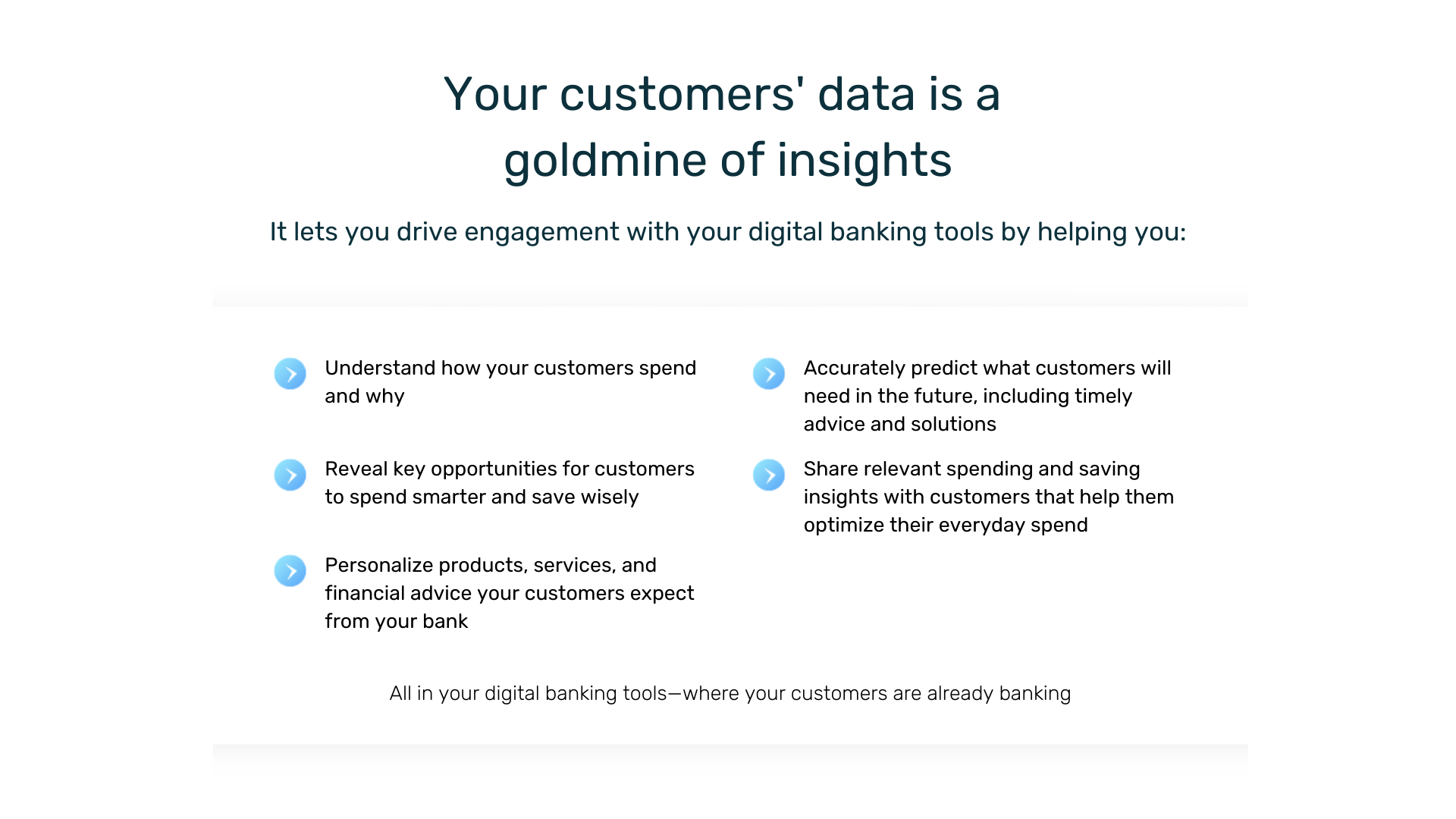4 advantages of using data to power your digital banking strategies
Image credit: Sensibill
In 2021, the name of the digital banking game is data—but it’s not just the data you’ve got that counts. It’s what you do with it.
When it comes to helping your customers, there are four key advantages to using data to inform and power your financial institution’s digital banking strategies:
Your FI will come to understand its customers on a deeper level
Personalizing products, advice, and services to your customers becomes easier and more actionable for your FI
Financial literacy becomes a staple of your digital and mobile banking tools and touchpoints
Your FI gains access to the right customer data rather than more surface-level data
More on these four advantages below 👇
Why is data key to your digital banking strategies?
Between alternative fintechs, neobanks and challenger banks, and big tech, customers are constantly flooded with endless options that financial institutions have to compete with. And for their customers—especially the younger ones, like millennials and Gen Z—those long-standing, traditional banking solutions simply don’t make the cut.
All of this forces FIs to find new, unique ways to serve these segments with customer-centric, financial wellness-focused solutions that go beyond your typical online banking tools or mobile banking apps.
In fact, it means harnessing customer data to help customers become more financially resilient, understanding who they are and how they spend. The challenge lies in knowing what to do with that data—in the eyes of customers, most financial institutions struggle to understand them and their needs, leading many to believe that their FI has no impact on their financial health and wellbeing.
So, what can your FI do to change that sentiment? Well, you can start by integrating data into the core of your digital banking strategy (and start doing it today).
Let’s break down how.
1. Using data to understand your customers on the deepest level possible
Once upon a time, customers relied on their financial institutions for little more than the basics, like keeping their money secure and using simplified banking accounts for income and savings.
Fast forward to today, and the banking landscape is vastly different. Customers no longer want the bare minimum—they demand robust digital banking tools, personalized products, and curated advice from those they trust with their financial well-being.
In order to keep up with the big banks and big tech that are gunning for your customers, you need to use your customers’ data to help propel their financial wellness forward—starting with knowing who they are, how they spend, and what their real needs are.
Big tech has a pretty solid relationship with your customers. Does your institution?
This means looking at your customers’ everyday spend data as a goldmine of insights you can leverage to understand how purchase and spend behaviors not only match but also differ between your customers, leading to more effective segmentation and personalization.
The outcome: By understanding your customers as real people, you’ll have the insights necessary to understand what they need, when they need it, and how it will benefit them long-term. This nurtures more loyal, engaged, and financially resilient customers that repeatedly use your digital banking tools.
2. Personalizing advice and products to your customers
In recent years, customers’ demands for more personalized solutions have had them turning to their banks for help with their financial wellbeing. Customers want their banks and credit unions to help them achieve their goals through services and products that are targeted to them. Your financial institution needs deeper data if it hopes to offer that level of personalization.
When customers don’t get this from their FI, they turn to alternative service providers and banking services (like big tech) to take financial wellness and spend management into their own hands.
When 54% of customers want more specific, real-time banking offers, it’s clear that generic tools, services, and product offerings don’t cut it anymore.
For FIs, helping your customers and keeping them from turning to big tech requires two key things:
Provide the right financial advice and insights that help your customers understand their spend (and how they can nurture healthier financial habits); and
Tailor products and solutions to your customers that meet their needs right now, where they are at this stage of their lives, and where they’re headed
The secret lies in using your customers’ everyday spend data to understand them on a deeper level, which allows you to provide the most relevant, highly targeted, and financial wellness-focused insights to them—doing this at scale based on spend insights and segmentation.
The outcome: Serving your customers with timely, relevant, and beneficial services that make a positive impact on their financial health is a surefire way to retain them by building better, more trusting relationships with customers that will bank with you for life.
3. Making financial literacy the norm
Financial literacy has to start somewhere—why not with your FI?
Not every customer you have will be aware of and deeply knowledgeable about their finances and managing spend in general. That means a weekly newsletter or pamphlet in the mail can’t be the only strategy your FI has for educating customers.
But don’t worry—data can help solve for this.
Whether a customer has just signed up with your bank to open a new account or has kept a basic account or line of credit with you for years, you can use their spend data to tailor curated resources and advice to that customer based on their spend behaviors—all in your digital banking tools.
Providing customers with access to the right knowledge and insights from experts in your financial institutions can help them learn about their finances and take control of their spend habits. This can make the difference between customers who are struggling financially or thriving.
Financial education, information, and literacy should be the norm for every customer that banks with you—from that first digital touch-point to everyday tools, push notifications, email marketing, in-person interactions at branches, and more. With the right data, you’ll understand which financial literacy resources make the most sense for specific segments of customers—wherever they are in their financial journey.
The outcome: When you help your customers understand their spend and educate them on their finances, you nurture healthier spend habits and give them the tools they’ll use time and again to grow their wealth.
4. Harnessing the right data versus “more data”
Options for your customers are endless. They could bank with big tech—in fact, 40% of millennials are already willing to—or they could turn to an alternative fintech provider.
But they don’t have to. Not when your financial institution uses the right data to help them achieve their financial goals.
Now, there’s a lot of data you have at your disposal, so it doesn’t make sense to simply mine for more of it. Instead, you want to look at the right data—like that gathered from everyday spend that illuminates insights into life stages, life cycles, purchase behaviors, spend habits, savings opportunities, and more.
By harnessing this data, your FI can break down the barriers between itself and its customers. Consider the following:
The right data enables you to more effectively segment and serve customers, giving them the tailored services they’re looking for. This benefit can’t be ignored—not when 78% of customers are happy to share their banking data if they get better, faster services in return
When you understand your customers through the right data, you can better establish trust with them, where they’ll share their data with you in return for more personalized advice and solutions. This is critical, given 41% of the time, customers think the products and services their banks offer them are offered only with the bank’s best interest in mind
Your customers will turn to you as a trusted partner in their financial wellness journey if you show you’re invested in providing the right tools, products, and advice. For example, 42% of customers want their banks to provide them with timely insights and solutions as their needs arise
The outcome: Your financial institution gains access to more data as customers use your digital banking tools more frequently, resulting in better, richer insights from more meaningful data. You can share these insights with your customers and help them spend smarter, saving more wisely.
After all, more data is great, but the right data is better.
Want to learn how to practice more meaningful personalization? We’ve got you covered. Check out our full-length Ebook on personalization in digital banking 👏
Meet the author, Brad 🏀
Brad is our Product Strategy Director and an experienced product leader in both the private and public sectors. He’s also pretty great at basketball and has a newfound appreciation for quarantine haircuts.





